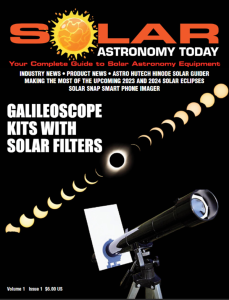The Earth and Space Expedition Center will host a Solar Observing Lab 2023 eclipse viewing event on Saturday, October 14th from 8am to 2pm Mountain Standard Time. The event is sponsored by Sky-Watcher USA, Focus on Astronomy and the Earth and Space Expedition Center.
 This special event provides a unique opportunity to get an up-close look at a wide range of today’s modern solar equipment. From eclipse glasses to advanced Hydrogen-alpha filters, the Solar Observing Lab 2023 eclipse viewing event will provide a chance explore a variety of solar equipment in one spot, in hopes, you will leave a with a better understanding of safe solar observing habits and maybe an idea on how you would like to purse solar astronomy.
This special event provides a unique opportunity to get an up-close look at a wide range of today’s modern solar equipment. From eclipse glasses to advanced Hydrogen-alpha filters, the Solar Observing Lab 2023 eclipse viewing event will provide a chance explore a variety of solar equipment in one spot, in hopes, you will leave a with a better understanding of safe solar observing habits and maybe an idea on how you would like to purse solar astronomy.
There will be a number of experienced astronomers on site showcasing their equipment as well as answering questions. Eclipse glasses will be provided while supplies last.
Specialized telescopes will be available for safe viewing of the sun in various wavelengths between 8am to 11:30am. These will include:
– Sky-Watcher Esprit 150EDT
– Sky-Watcher Esprit 100EDT
– Stellarvue SVX-180T
– Stellarvue SVX-90T
– Coronado Solarmax 90DS
– Lunt LS100THa
– Lunt LS60THa DS
– Lunt LS40THa DS
– Sky-Watcher AZEQ-6
– Sky-Watcher AZEQ-5
– Sky-Watcher EQ8-Rh
Those wishing to bring their own telescopes will need to sign up through focusastronomy@gmail.com to help the organizers know how many telescopes/astronomers will be on site. Set up time for astronomers will be 6:30am to 7:45am. Gates close for astronomer entry at 7:45am.
You can learn more about the Solar Observing Lab 2023 eclipse viewing event here.

 And to make it easier for you to get the most extensive news, articles and reviews that are only available in the magazine pages of Astronomy Technology Today, we are offering a 1-year magazine subscription for only $6! Or, for an even better deal, we are offering 2 years for only $9. Click here to get these deals which only will be available for a very limited time. You can also check out a free sample issue here.
And to make it easier for you to get the most extensive news, articles and reviews that are only available in the magazine pages of Astronomy Technology Today, we are offering a 1-year magazine subscription for only $6! Or, for an even better deal, we are offering 2 years for only $9. Click here to get these deals which only will be available for a very limited time. You can also check out a free sample issue here.
The Sun is more active than it’s been in years and if that’s not enough, we have the Annular Solar Eclipse on October 14, 2023 and the Total Solar Eclipse on April 8, 2024! If you’d like to learn more about the technology behind solar observing, solar imaging and more, you can check out our new monthly magazine – Solar Astronomy Today. It’s free to read, no subscription needed and available here. And if you are preparing for the upcoming eclipses and want to know your equipment options from solar glasses to the most out of this world solar viewing and imaging options, check out our free publication – The Definitive Guide to Viewing and Imaging the Sun – simply click here and enjoy reading!

